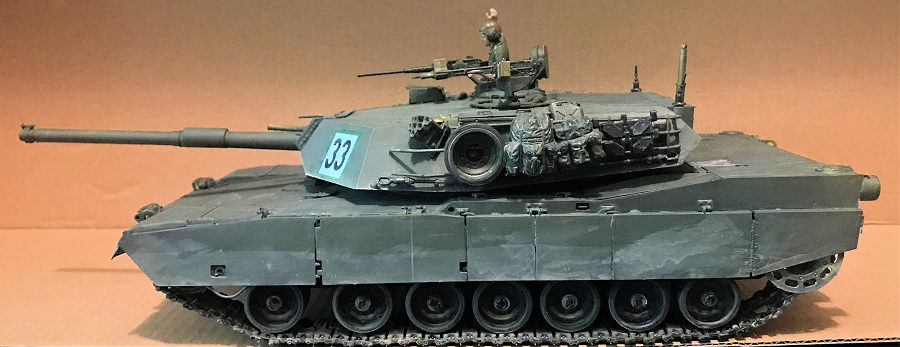
| KIT #: | PH35030 |
| PRICE: | $45.00 |
| DECALS: | Four options |
| REVIEWER: | Donald Zhou |
| NOTES: | Advantages: Extremely detailed, various options, newer option to the ancient Tamiya M1. Disadvantages: multi-piece track assembly, Too small photo-etch. Tamiya Modern U.S. Equipment Set used. |

| HISTORY |
The M1 series of tanks was developed in the 70’s as a replacement for the venerable M60. Previously, in a joint program with then West Germany, the U.S. produced the MBT-70 in the ‘60’s as a replacement. That never worked. The then new 155mm short barreled cannon, which can fire the Shillelagh missile was prone to break down and jamming. The rest of the vehicle didn’t fare better either and both nations eventually backed out. The Germans went on to produce their own very successful Leopard II MBT while the U.S. went on to eventually produce the M1.
The first prototype was produced in 1976. The winner was Chrysler. The Germans, who were adamant on selling the Leopard to the U.S. was deemed too expensive while the GM design was deemed too inferior. The tank was the XM1. After Chrysler was bought out by General Dynamics, the design was further improved. It had the same 105mm Royal Ordnance cannon found on the M60, which is upgradable to the 120mm Rhinemetal smoothbore found on the Leopard II. It also had massive improvement to the armor with the British Chobham ceramic armor plates that’s a whole generation ahead of the rolled homogeneous armor found in the M60. The biggest improvement however, was the fire control system. Previous tanks all used analogue sights with daylight vision systems. The M1 replaced them with digital fire control computers with laser range finders that was several jumps ahead along with a Forward Looking Inferred sensors that allowed the tank to fight at night or bad weather. Efficiency were greatly improved although older more experienced crews’ improvement was only incremental. However, the improvements among new raw crews was three or even four times better than older tanks, meaning they can be brought up to standard far quicker. The tank entered service in 1980 and quickly started to prove themselves. Over 3300 M1 were produced. The tanks can run up to 45MPH although there are reports of crews who disabled their governors on the tanks and went up to 55MPH and even beyond! The tank also features an AGT-1500 turbine engine. The engine is quiet, so quiet in fact, the tank gained a nickname of whispering death and can use any sort of fuel, everything from diesel, to straight gasoline and in a pinch, raw alcohol can be burned (although as might surmised, using raw alcohol will wreck the engine’s life). In service, the tank just uses diesel to save logistics nightmares. However, the big disadvantage is the turbine is a huge fuel hog and draws as much as a gallon of fuel for every mile and its infer-red signature is also quite high.
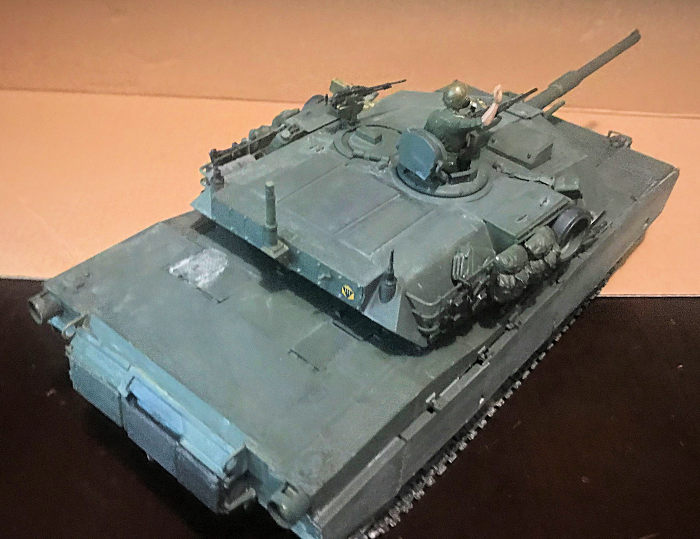 The next
major upgrades is the M1A1 version. The biggest difference is the main armament.
The Rhinemetal 120mm smoothbore replaced the British 105mm rifled cannon. This
meant ammo capacity was dropped from 53 to 42. The other was the armor.
Especially the HA (Heavy Armor) and HC (Heavy armor Common) variants, which
contained a layer of depleted Uranium to further harden and upgrade the armor.
Other improvements includes better bustle racks and a hole was opened just in
front of the loader. This hole will prove critical for the next series of
upgrade then in development. Over 6000 M1A1’s were produced, many of them are
now or have been upgraded under the AIM or Abrams Improvement Management
program.
The next
major upgrades is the M1A1 version. The biggest difference is the main armament.
The Rhinemetal 120mm smoothbore replaced the British 105mm rifled cannon. This
meant ammo capacity was dropped from 53 to 42. The other was the armor.
Especially the HA (Heavy Armor) and HC (Heavy armor Common) variants, which
contained a layer of depleted Uranium to further harden and upgrade the armor.
Other improvements includes better bustle racks and a hole was opened just in
front of the loader. This hole will prove critical for the next series of
upgrade then in development. Over 6000 M1A1’s were produced, many of them are
now or have been upgraded under the AIM or Abrams Improvement Management
program.
The tank, now named Abrams after late Gen. Creighton Abrams, baptism of fire came in the Middle East. When Iraq and Sadadum Insane invaded Kuwait, U.S. and her allies quickly formed a line of defense to defend Saudi Arabia. Critical among the pieces were Abrams. In fact, over 1800 of the tanks were sent to the Gulf, many of them the latest HA variants to deal with the T-72’s. Before the battle, questions about the tank’s price and effectiveness abound but all of that was settled quickly when the tank proved itself in battle.
In fact, the Abrams totally outclassed its opponents. It can hit its targets as far away as 2KM away and its rangefinders and FLIR worked well in both daylight and night, especially when smoke fire engulfed the region. In fact, one anecdote from the war shows just how near invulnerable the tank was. During a drive, one Abram got stuck in mud. The rest of the unit passed it by since they were under orders to keep moving. While waiting for a tow, three Iraqi T-72’s attacked. The first one fired a HEAT shell and did nothing to the tank. The M1 responded by firing an armor piercing shell that nearly blew the turret off! The second one, not heeding the lesson, also fired a HEAT shell that only made the tank angrier. A second round turned this tank into a funeral pyre. The third tank, finally heeding the warning, fired an armor piercing round that left a grove in the Abrams frontal glacis plate but did not penetrate. Seeing further fighting was redundant, it hid behind a sand berm, thinking it was safe. However, through its FLIR unit, the Abram tracked the last Iraqi tank and saw the heat plume from its exhaust and put the round where the turret was. The armor piercing round slammed through the sand berm and still penetrated the tank on the other side.
By this time, further Abrams had arrived but still no tow truck…Orders came from above to destroy the stricken tank in place. Since the rest of the Abrams crews did not have high explosives, they decided to use their main cannons for the job.
However, two rounds against the front armor proved to be useless, a tank came up against the side and fired one through the ammo storage bin and finally penetrated. All that did was to set off the blast off panel on top of the turret, which vent the explosive force upwards. After the fire died down, the tank proved to be as tough as ever! While discussing on what to do, the tow finally arrived and with three M88 recovery vehicles, the stricken M1 was finally dragged out of the mud!
There were some hard lessons too though. The least of which, like the M2 Bradley, it turned out, the biggest enemy wasn’t the enemy…it was friendly fire. Of the 9 Abrams destroyed in the war, 7 was from friendlies. At least two was from an errand AH-64 Apache strike with one total loss
After the war, further improvements were added. The biggest was the M1A2 version. The hole on top of the tank was replaced by a CIV or Commander Independent thermal Viewer. This allowed the tank to finally conduct “Search while hunt” at the same time. Electronics were further improved to allow one A2 to talk to another or any similarly equipped tank. Furthermore, to guard against the painful lesson of friendly fire, “cold” identification panels were added to the front of the turret, the side and rear. The A2 was also improved with the SEP or System Expansion Program and the SEP2, which added FBCB2 and other improvement to the armor etc.
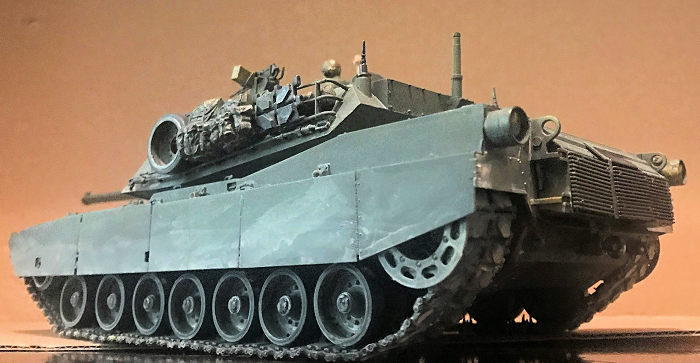 By the
time the second Gulf War rolled around, the Abrams that participated in this war
only look like the same Abrams that participated in the first one. The insides
though, were completely different and generations ahead. After the war, however,
the Abrams faced its toughest test yet, fighting in urban terrain.
By the
time the second Gulf War rolled around, the Abrams that participated in this war
only look like the same Abrams that participated in the first one. The insides
though, were completely different and generations ahead. After the war, however,
the Abrams faced its toughest test yet, fighting in urban terrain.
The fact of the matter is, tanks are not suited in urban terrain. They are too big, too unwieldy in a city and there are a lot of spots for insurgents to take pot shots at it. The press were quick to point out the Russian disaster that was Chechenia and Grozny. Insurgents quickly found out going toe to toe with an Abrams was tantamount to suicide. However, taking pot shot at it from the rear or firing an RPG from the rooftop at the tank’s roof is a far better option. Either that, or load up an IED and then blow up its soft underbelly!
To combat this, the Tank Urban Survival Kit upgrade was developed. This is a field upgradable kit that radically improve the tank’s survival in an urban terrain. The first thing added was something from WW II, an infantry to tank talkie phone on the back. The next one was a “V” shaped armor piece that was added to the belly to not only add armor strength against IED’s, but also to blunt and deflect the blast away from the tank. The third is a series of armor glass panes were added to both the commander and the loader’s weapon stations so they can operate their weapons out of the tank without worrying about snipers. Finally, to guard against the tank’s sides, a series of ERA armor panels were added to the tank’s side skirts.
When introduced, the kit quickly proved popular and well suited in an urban terrain. However, further improvements were added from combat reports. These became the TUSK II kit. These includes: further slate armors were added to the rear engine grill. A second .50 cal machine gun was added to the top of the main cannon and a series of ceramic tile ERA armor pieces were added to the turret sides and onto the existing side skirt ERA armor.
With these improvements, the tank soon proved to be a hard nut to crack. There is a M1A3 version. However, due to budget cuts, that version is in limbo so the Army and Marines will have to do with the current version for the foreseeable future.
| THE KIT |
Panda hobby is a somewhat new armor company that seem to balloon out of China every other month! They are very welcome since they seem to tackle subjects other company don’t want to such the HMEE (which I also have and want to finish once some of these kits get cleared off the bench), Tunguska and this, the very first version of the M1.
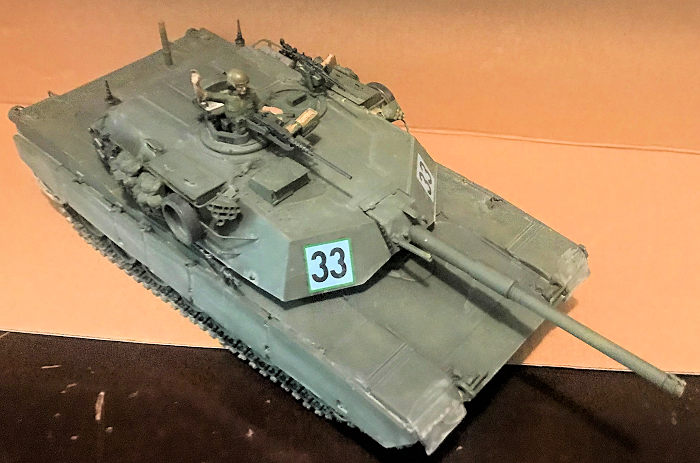 Before
this, the only other option is the very ancient Tamiya M1 that came out in the
early 80’s. It’s still viable if you can find it and I did built it some 30
years prior. However, it’s filled with details mistakes as its based on the
prototype M1, not the production one. However, it costs as little as $20 bucks
so there is that….
Before
this, the only other option is the very ancient Tamiya M1 that came out in the
early 80’s. It’s still viable if you can find it and I did built it some 30
years prior. However, it’s filled with details mistakes as its based on the
prototype M1, not the production one. However, it costs as little as $20 bucks
so there is that….
So few years ago, Panda Hobby released their M1 Abrams as a replacement to the ancient Tamiya one. See Scott’s preview here:
It’s far more accurate and detailed than the previous one. However, two things really put me off. One is the pesky multi-piece tracks. The other is the too small photo-etch tow cable brackets. The tracks, I can’t avoid. The tow cable, thank you again my M1 ABV kit! That still contains the original Abrams tow cables…Sigh, gotta get that thing completed…Those mine plows…I wanted the original M1 to go with my RFM M1A1 Abrams with the interior, the 1/16 M1A2, the M1A2 SEP with TUSK II, and the M1A2 SEP II…Yes, time to complete my Abrams “evolution” collection!
Otherwise, this is a very mundane armor kit. Time to get started
| CONSTRUCTION |
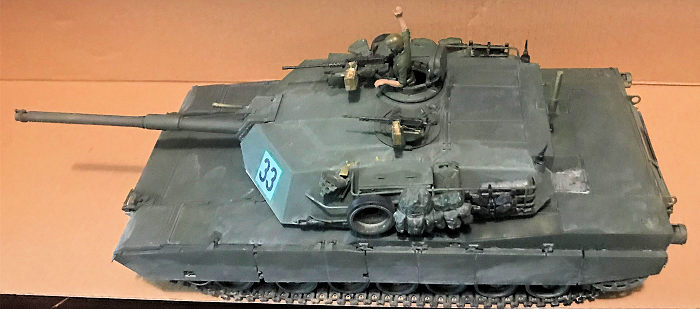 I’ve
built so many Abrams, that I won’t reinvent the wheel here, especially as I’ve
said, main construction is pretty mundane. Basically, lower hull, just the
driver hatch, the many road wheels and the rear assemblies. Notice again, the
hubs are clear since the real thing has clear Plexiglas hubs. I didn’t add
anything that look like carpet monster food.
I’ve
built so many Abrams, that I won’t reinvent the wheel here, especially as I’ve
said, main construction is pretty mundane. Basically, lower hull, just the
driver hatch, the many road wheels and the rear assemblies. Notice again, the
hubs are clear since the real thing has clear Plexiglas hubs. I didn’t add
anything that look like carpet monster food.
Turret goes main cannon together…Yes, it should be one piece but ohh well….It still works. Then the barrel is trapped between the two turret halves and then the accessories can go on, grenade launchers, the loader’s hatch, the tool boxes, and the turret fences. Main construction is pretty fast consideringly since they is all basic armor making stuff…The hard part is coming up…Yep! The tracks! But first things first….Time to get some paint on!
| COLORS & MARKINGS |
So I picked the version that contained the number “33” on the front of the turret. It’s overall in “Forrest Green”…..Took me a while, but it seems Tamiya’s NATO Green is a very close approximation so I used that. It worked well. I sprayed to the tank itself, the commander’s cupola, the side skirts and various accessories that needs it. I then weathered it with my usual methods, not too much since the tracks are not on yet and I do want this to represent an Abrams that first entered service so many moons ago so weathering will be somewhat light…The rest of my Abrams are the dirty puppies. Then gunmetal for the machine guns, brass for the shells etc. Painting was actually short this time. The most time consuming part is next,
| CONSTRUCTION CONTINUES |
Time for the tracks. These are a
mind number…What happen is, two tracks are used to trap the guide tooth in the
middle. The track pattern is correct for an early version of the M1. This is
snap tight. Then two side pinchers are used to hold the tracks in place. Due to
the fact these are pretty loose, I had to cement one part shut and leave the
other one free to rotate since you need the tracks to be loose to go around the
idler wheels and sprockets. The only good thing again, with Abrams, is that you
don’t 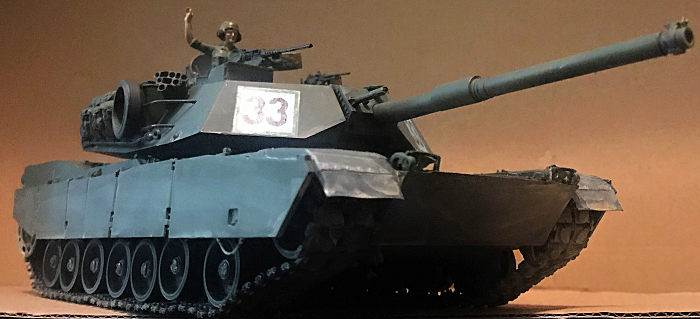 need
the entire track run since the massive side skirts cover up the top rung so I
only assembled half a length each. This still took a while since well…Did I tell
you this is pretty mind numbing? Took me two weeks to do this and then a spray
of flat black since they are all desert tan plastic.
need
the entire track run since the massive side skirts cover up the top rung so I
only assembled half a length each. This still took a while since well…Did I tell
you this is pretty mind numbing? Took me two weeks to do this and then a spray
of flat black since they are all desert tan plastic.
After that, the tracks were assembled onto the tank. Next are all the side skirt. Follow the instruction carefully here so you know what goes where.
Next is the commander cupola. This is already sprayed previously. The periscopes are inserted first, then the hatch, which I assembled in the open position since I reached into my bag of tricks and pulled out my ancient Tamiya M2 Bradley’s commander figure, repaint it a bit, and inserted him into position. Had to create a foot stand for him underneath but no biggie. Next are all the machine guns on top. The kit do offer open ammo box with ammo belts so I used those. The last bit is the tow cables. Again, really tinnie winnie photo etch brackets are offered…It seems sometimes manufactures enjoy making a big pain in the “ta” section of the PITA! I stole my M1 ABV tow cables instead since RFM offers the regular ones with molded on brackets. I then went to the weathering process again to weather down the skirts and the rest. And to add some interests, I used four ALICE packs and some spare tracks from the Tamiya U.S. Modern Tank Accessory Kit to spruce up the model a bit. These were painted and weathered in their relevant colors before added onto the tank. Model done.
| CONCLUSIONS |
Overall, this is your average joe kit….All except the too small photo-etch parts and the pesky multi-piece tracks. However, the Tamiya kit is long out of production and EvilBay is charging an arm and a leg for one so this is your only option. Except the last two, it’s far more accurate and more detailed so the only thing left is just working up the courage to deal with the tracks. Luckily as stated, the side skirts does a great job covering up the upper rung so you only need to make half a length for each side. Overall recommended.
Donald Zhou
24 May 2021
Copyright ModelingMadness.com. All rights reserved. No reproduction without express permission.
If you would like your product reviewed fairly and fairly quickly, please contact the editor or see other details in the Note to Contributors.